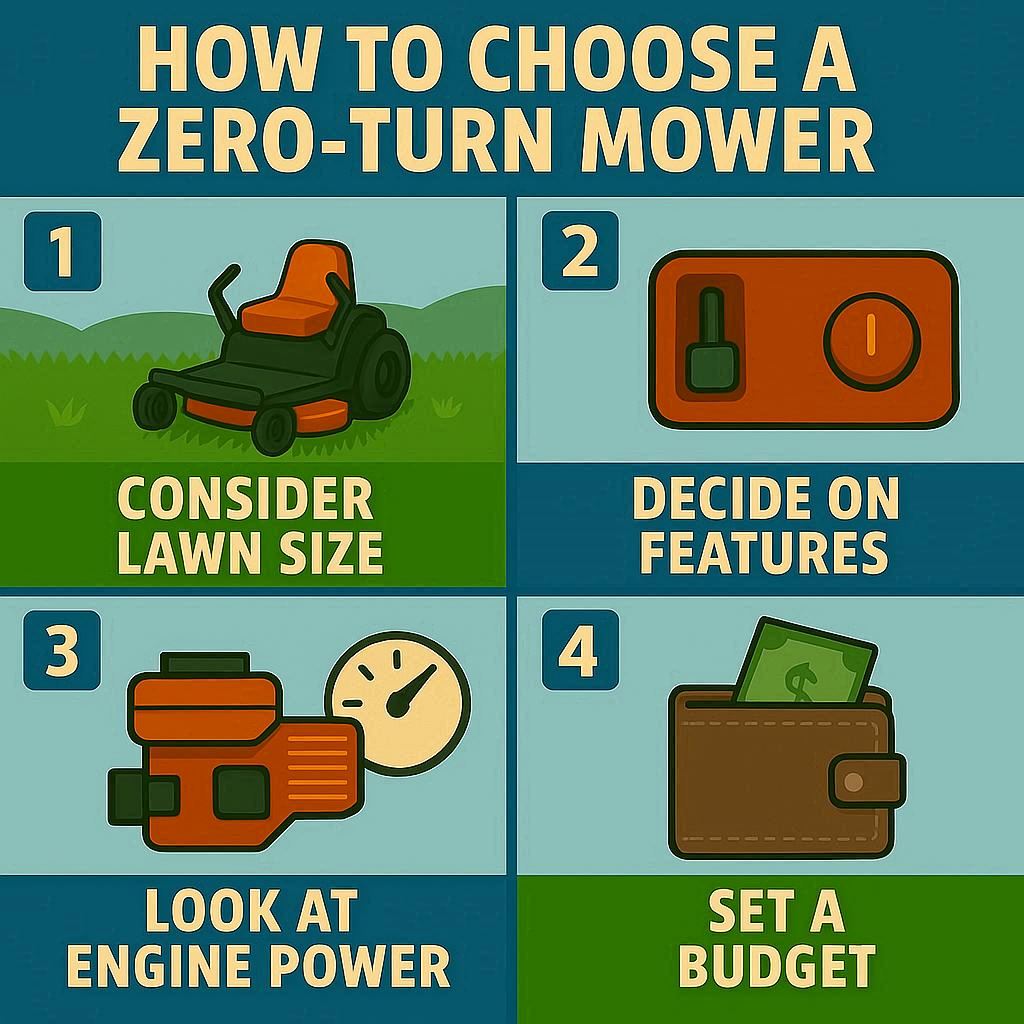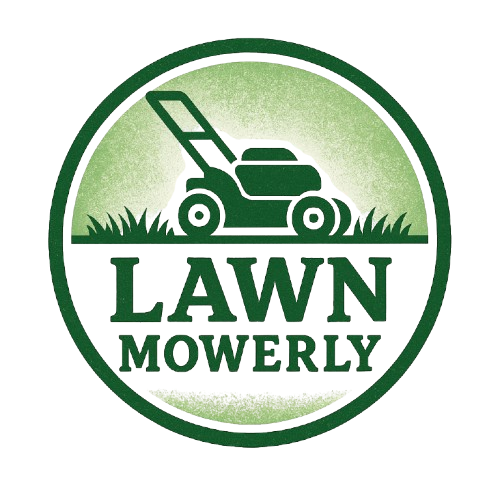
Zero-turn mowers have transformed lawn care with their unmatched maneuverability and speed, making them a go-to for homeowners and professionals alike. Choosing the right zero-turn mower involves understanding your lawn, evaluating technical features, and considering your comfort and budget. This comprehensive guide walks you step-by-step through the decision process, with detailed explanations and practical advice for long-term ownership.
1. Assess Your Yard and Usage
A. Size of Your Lawn
- For lawns under ½ acre: Compact and residential zero-turn mowers with smaller decks (30–42″) are typically ideal—maneuverable and cost-effective.
- For ½ to 2 acres: Residential zero-turns with 42–54″ decks combine coverage and agility.
- For 2+ acres: Commercial-grade or large residential machines (54–72″ decks) offer efficiency and speed for wide-open spaces.
-
B. Terrain and Obstacles
- Flat/Lawn: Any zero-turn mower will handle this well.
- Sloped or Uneven Yard: Many ZTRs are not ideal for steep inclines (over 15°); choose a model with added stability, wide tires, or consider alternatives for very hilly terrain.
- Obstacles (trees, beds): A smaller deck and tighter turning radius make maneuvering around landscape features easier.
C. Intended Use
- Homeowners: Lighter-duty models with simpler controls.
- Professionals: Heavy-duty construction, larger engines/decks, commercial warranties, and higher fuel capacity for all-day operation.
2. Understand Key Zero-Turn Mower Features
A. Deck Size and Construction
- Deck size determines cutting width—wider decks finish large areas faster but can be unwieldy in tight spots.
- Residential: 34–54 inch decks.
- Commercial: Up to 72 inches.
- Check the deck material (stamped vs. welded steel), the number of blades, anti-scalp wheels for uneven ground, and height adjustment options.
B. Engine Power and Type
- Residential units: 15–25 HP (horsepower).
- Commercial units: Up to 35 HP or more, offering better performance in heavy grass.
- Look at brands (Kawasaki, Kohler, Briggs & Stratton, etc.) and opt for easy access for maintenance.
- Consider fuel source: gas, electric (emerging), or propane for lower emissions and longer tank life.
C. Transmission and Speed
- Hydrostatic transmissions are common—allow smooth, variable speed control via lap bars.
- Better quality transmissions last longer under heavy use.
- Top speed matters for large properties (ranges from 5 to 13 mph).
D. Comfort and Ergonomics
- Look for padded, adjustable seats with built-in suspension and armrests for long mowing sessions.
- Ease of control: Lap bars vs. steering wheel; clear, intuitive dash controls.
- Features like cup holders, vibration dampening, convenient deck-lift levers, and even sun canopies can improve comfort.
E. Durability and Build Quality
- Commercial models feature heavier frames, better welds, high-quality wheels, and heavy-duty spindles—essential for longevity under constant use.
- Check warranty terms: commercial use often voids residential mower warranties.
3. Technical Considerations and Additional Features
A. Starting System
- Electric starts are standard and convenient; manual (pull) starts are rare.
B. Controls
- Lap bar steering is most common, requiring some learning curve but offers tight zero-radius turns.
- Some newer models provide steering wheel controls for easy transition from tractors—worth considering for comfort/preference.
C. Tires and Traction
- Larger rear tires = better traction and comfort.
- Consider “run-flat” tires and wider tires for greater grip, especially on slopes or damp ground.
D. Safety Features
- Rollover protection (ROPS) bars for commercial/professional models.
- Seat belts, interlock switches, and blade/power cut-offs for stopping during emergencies.
E. Accessories and Attachments
- Baggers, mulching kits, tow-behind carts, snow blades, light kits, striping kits, and even aerators can extend function.
- Check compatibility before purchase.
4. Maintenance, Support, and Long-Term Ownership
A. Maintenance:
- Easy access to vital service points (oil, filters, belts, blades).
- Evaluate if the mower brand has a strong dealer network and easy-to-source parts for peace of mind and easier repairs.
B. Cost vs. Value
- Calculate long-term operating costs: fuel, maintenance, blade/belt replacements, and possible repairs.
- Budget for accessories or future upgrades.
C. Storage:
- Ensure you have space—a larger mower may require a dedicated area in your garage or shed.
5. Brands, Reviews, and Dealer Support
A. Brands
- Well-known names include John Deere, Toro, Husqvarna, Cub Cadet, Ariens, Exmark, Gravely, and Snapper.
- Each brand offers unique models and may have special strengths (durability, ergonomics, feature set).
B. Local Dealer and Service
- Buy from a reputable dealer who provides after-sales support, part availability, and warranties—crucial for maintenance and repairs.
C. Read Reviews and Ask for Demos
- Use verified user and expert reviews online.
- If possible, test drive your top choices before making a final decision.
6. Step-by-Step: How To Choose
- Measure your lawn and identify major obstacles.
- Decide on deck size and power based on your property’s needs.
- Set your budget—plan for both the mower and accessories/maintenance costs.
- List your must-have features (comfort, attachments, safety, etc.).
- Shortlist the brands/models that suit your needs.
- Visit local dealers for advice, demos, and support info.
- Compare warranties and after-sales support.
- Make an informed purchase, keeping future needs in mind.
FAQ: Zero-Turn Mower Buying
Q1: What makes a zero-turn mower different from a traditional lawn tractor?
A: Zero-turn mowers use independent wheel motors controlled by lap bars (or a steering wheel on some models), allowing zero-radius turns. This makes them more maneuverable—especially around landscaping features and obstacles—than typical riding tractors.
Q2: How do I know which deck size is right for my lawn?
A: For lawns under 1 acre, a 34-42″ deck is ideal. For 1–2 acres, use a 42-54″ deck. Above 2 acres, consider a 54-72″ deck for speed—but only if your layout allows for it.
Q3: Are zero-turn mowers good on hills?
A: Most zero-turn mowers work best on flat to gently rolling lawns. On slopes over 10-15 degrees, traction and safety become issues. If you have lots of hills, consult your dealer and consider models built for slope stability or alternative machines.
Q4: What maintenance do zero-turn mowers need?
A: Regular oil changes, air and fuel filter replacement, belt and blade checks, tire pressure, deck cleaning, and seasonal inspections. Always follow the manufacturer guidelines.
Q5: Are electric zero-turn mowers as powerful as gas models?
A: Electric zero-turns are growing in power but may not match the hardest-working professional gas models yet. They are, however, lower-maintenance, quieter, and better for the environment, and are increasingly viable for small to medium lawns.
Q6: Can a zero-turn mower handle wet or tall grass?
A: High-powered models handle thick and tall grass better. In wet conditions, use caution: ZTRs can lose traction and cause ruts; always mow when grass is dry for best results.
Q7: Should I buy a residential or commercial zero-turn mower?
A: If you mow several acres regularly or operate a landscaping business, a commercial unit is worth the investment. For smaller home lawns with lighter use, a residential model offers the best value.
Q8: What additional accessories or attachments are useful?
A: Baggers (for clippings), mulching kits, striping rollers, lights, snow blades, and tow-behind carts are common—always check compatibility.
Q9: How long does a zero-turn mower last?
A: With maintenance, a quality residential ZTR can last 1,500–2,000 hours. Commercial units, built heavier, often last longer with proper care.
Q10: Where should I buy my zero-turn mower?
A: Local dealers provide invaluable support, warranty service, and model recommendations. Major brands are sold at dealers, farm supply stores, and large home improvement chains, but after-sales support is a huge advantage with dedicated dealers.
Final Thoughts
Buying a zero-turn mower is a significant investment in your property and productivity. By evaluating your lawn’s needs, understanding key machine features, prioritizing comfort and support, and seeking reputable brands, you’ll ensure years of reliable, efficient mowing. Use this guide as your foundation and don’t hesitate to reach out to local dealers for hands-on advice and demonstrations.

I’m David man behind Lawn Mowerly; I’ve been dealing with lawnmowers and Tractors with my father since I was a kid. I know every make and model and what each one is capable of and love helping people find the perfect equipment for their needs.
